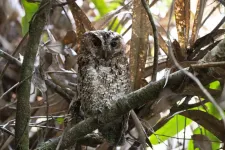INFORMATION:
The research was funded in part by the Regenerative Medicine Program of the NIH Common Fund and in part by the NCATS intramural research program.
About the National Center for Advancing Translational Sciences (NCATS): NCATS conducts and supports research on the science and operation of translation -- the process by which interventions to improve health are developed and implemented -- to allow more treatments to get to more patients more quickly. For more information about how NCATS helps shorten the journey from scientific observation to clinical intervention, visit https://ncats.nih.gov.
About the National Institutes of Health (NIH): NIH, the nation's medical research agency, includes 27 Institutes and Centers and is a component of the U.S. Department of Health and Human Services. NIH is the primary federal agency conducting and supporting basic, clinical, and translational medical research, and is investigating the causes, treatments, and cures for both common and rare diseases. For more information about NIH and its programs, visit https://www.nih.gov.
NIH...Turning Discovery Into Health®
Scientists find small molecule cocktail to improve stem cell use in research, medicine
2021-05-03
(Press-News.org) Researchers at the National Institutes of Health (NIH) have devised a four-part small-molecule cocktail that can protect stem cells called induced pluripotent stem cells (iPSCs) from stress and maintain normal stem cell structure and function. The researchers suggest that the cocktail could enhance the potential therapeutic uses of stem cells, ranging from treating diseases and conditions -- such as diabetes, Parkinson's disease and spinal cord injury -- to genome editing.
Human pluripotent stem cells are cells that, in theory, can grow forever and serve as an inexhaustible source for specialized cells, such as brain, kidney and heart cells. But stem cells are sensitive, and their potential uses in medicine are hampered by the stress of growing in a cell culture dish, which can damage their DNA and lead to cell death.
In a series of experiments, scientists led by Ilyas Singeç, M.D., Ph.D., director of the Stem Cell Translation Laboratory at NIH's National Center for Advancing Translational Sciences (NCATS), used high-throughput screening to systematically test thousands of compounds and drugs to identify a unique combination that greatly improved stem cell survival and reduced cell culture stress. Singeç and his co-investigators described how they developed the cocktail, called CEPT, and its potential applications May 3 in Nature Methods.
"The small-molecule cocktail is safeguarding cells and making stem cell use more predictable and efficient. In preventing cellular stress and DNA damage that typically occur, we're avoiding cell death and improving the quality of surviving cells," said Singeç. "The cocktail will become a broadly used staple of the stem cell field and boost stem cell applications in both research and the clinic."
iPSCs are derived from reprogrammed skin or blood cells. To improve their survival in culture, Singeç and his team initially tested more than 15,000 U.S. Food and Drug Administration-approved drugs and investigational small-molecule compounds from NCATS' collections. Among the 20 drugs and compounds that could inhibit the activity of ROCK, a type of kinase enzyme that is involved in stem cell stress, they found that the compound Chroman 1 was more potent than the widely used compound Y 27632 in improving cell survival.
To further improve cell survival, Singeç and his colleagues used NCATS' matrix drug screening capabilities to look for potential synergies between Chroman 1 and other drugs and compounds. Matrix drug screening enables investigators to study the effects of drug combinations and determine possible mechanisms by which these drugs act. The researchers identified an investigational drug, Emricasan, that, when combined with Chroman 1, could provide additional support to improve stem cell viability.
According to Singeç, an important effort in stem cell biology is an experimental process called single-cell cloning. Although culturing stem cells in large groups is easier, single-cell cloning -- culturing one cell at a time in a tiny well of a cell culture plate -- is very stressful to cells and inefficient. The process has critical applications in gene editing and establishing cell lines, which are cell cultures developed from a single cell.
In its initial screening work, the team tested the protective effects of drugs and compounds on 500 stem cells at a time in plate wells. To mimic the cell stress seen during single-cell cloning, the researchers then developed a new assay (test) to allow them to examine the effects of more than 7,500 compounds on only 10 cells at a time.
This testing led to the identification of a third compound, trans-ISRIB, that enhanced cell survival, even when there were few cells in each plate. Additional experiments showed that a mixture of compounds called polyamines -- in combination with Chroman 1, Emricasan and trans-ISRIB -- proved best for single-cell cloning.
"Cells need to be cultured properly, and they have to be of good quality to go into patients," said NCATS Acting Director Joni Rutter, Ph.D. "By finding new ways to protect stem cells from damage, these results could eventually have wide-ranging implications for many different diseases, including cancer, Alzheimer's disease and more."
The team carried out an array of experiments to test the usefulness of the cocktail. The researchers showed, for example, that CEPT improved the biobanking of stem cells, called cryopreservation, which involves freezing the cells and typically is very stressful for them. Cryopreservation is critical to bringing stem cells to the clinic, but significant numbers of cells are lost or damaged during the thawing process. The cocktail dramatically improved the process.
In another test, the researchers studied the use of the cocktail on iPSCs that already were differentiated into heart cells, motor neurons and other cell types. They found that these more differentiated cells treated with CEPT also were more viable and showed improved function. Singeç also noted potential uses for the cocktail in tissue engineering and the biomanufacturing of various cell types for regenerative medicine and drug development.
"For the last 20 years, we have not been able to culture human stem cells in the most optimal conditions," Singeç said. "Our approach could improve safety and ensure that the next-generation stem cell lines are cultured at high quality before moving into the clinic."
ELSE PRESS RELEASES FROM THIS DATE:
Mini 3D brain models could speed up search for MS treatments
2021-05-03
Tiny 3-D models that mimic vital aspects of the human nervous system have been developed in a step that could accelerate drug research for neurological conditions such as multiple sclerosis (MS).
The millimetre-wide models - created using stem cells from human skin samples - will be used to study myelin, an insulating substance that helps nerve cells communicate with each other.
Researchers say the models are the most natural representation of human myelination developed in a lab and are a promising platform for studying neurological diseases and for testing drugs for conditions linked to myelin loss, including MS.
Nerve cells are found in the brain and the spinal cord and connect to each other with ...
COVID-19 conspiracy beliefs increased among users of conservative and social media
2021-05-03
PHILADELPHIA - Belief in conspiracies about the COVID-19 pandemic increased through the early months of the U.S. outbreak among people who reported being heavy users of conservative and social media, a study by Annenberg Public Policy Center (APPC) researchers has found. ...
Stress and mental health problems during first COVID-19-lockdown
2021-05-03
Many people in Switzerland experienced considerable psychological distress during the first COVID-19 lockdown from mid-March to the end of April 2020. Researchers from the Department of Child and Adolescent Psychiatry and Psychotherapy at the University Hospital of Psychiatry Zurich (PUK) and the University of Zurich in collaboration with the La Source School of Nursing have now examined the most common sources of stress among children, adolescents, their parents and young adults. For their study, the researchers used representative samples in Switzerland of 1,627 young adults aged 19 to 24 as well as 1,146 children and adolescents between the ages of 12 and 17 and their parents.
Uncertainty, disruption, postponement
"Uncertainty during last year's lockdown was considerable ...
Flatfish got weird fast due to evolutionary cascade
2021-05-03
HOUSTON - (May 3, 2021) - Ever look at a flatfish like a flounder or sole, with two eyes on one side of its head, and think, "How did that happen?"
You're in luck. Rice University biologist Kory Evans has the answer.
"Flatfishes are some of the weirdest vertebrates on the planet, and they got weird very, very fast by changing multiple traits at once over a short period of time," said Evans, an assistant professor of biosciences at Rice who specializes in studying the evolution of fish over long time scales.
Of all mammals, reptiles, birds, amphibians and fish, flatfish are easily the most asymmetric. Evans, the corresponding author ...
Equipping crop plants for climate change
2021-05-03
Biologists at Ludwig-Maximilians-Universitaet (LMU in Munich) have significantly enhanced the tolerance of blue-green algae to high light levels - with the aid of artificial evolution in the laboratory.
Sunlight, air and water are all that cyanobacteria (more commonly known as blue-green algae), true algae and plants need for the production of organic (i.e. carbon-based) compounds and molecular oxygen by means of photosynthesis. Photosynthesis is the major source of building blocks for organisms on Earth. However, too much sunlight reduces the efficiency of photosynthesis because it damages the 'solar panels', i.e. the photosynthetic machineries of cyanobacteria, algae and plants. A team of researchers led by LMU biologist Dario Leister has ...
Genetics, not the intrauterine environment, controls abnormal development
2021-05-03
New Haven, Conn. --Yale researchers have shown that developmental abnormalities, including those that lead to pregnancy loss and autism, are controlled by the genetics of the fetus and placenta -- and not the mother's intrauterine environment.
The findings are reported in the April 28 online edition of the journal Placenta.
One out of every 33 children is diagnosed with a birth defect each year in the United States, according to the Centers for Disease Control and Prevention (CDC). This translates into one baby born every 4 ½ minutes -- or 120,000 per year.
"Mothers ...
Newly identified saber-toothed cat is one of largest in history
2021-05-03
COLUMBUS, Ohio - A giant saber-toothed cat lived in North America between 5 million and 9 million years ago, weighing up to 900 pounds and hunting prey that likely weighed 1,000 to 2,000 pounds, scientists reported today in a new study.
The researchers completed a painstaking comparison of seven uncategorized fossil specimens with previously identified fossils and bone samples from around the world to describe the new species. Their finding makes a case for the use of the elbow portion of the humerus - in addition to teeth - to identify fossils of large saber-toothed cats whose massive forearms enabled ...
Review outlines approaches to deliver radiation to tumors while sparing healthy tissue
2021-05-03
CHAPEL HILL, North Carolina--A comprehensive review by University of North Carolina researchers and colleagues highlights the optimal ways that focused, high-dose radiation can be delivered to various types of tumors while sparing normal tissue and mitigating long-term side effects. The review was reported as a special issue in the International Journal of Radiation Oncology, Biology, Physics on May 1, 2021.
This analysis was based on an exhaustive review of data and the literature published largely in the past decade. It updates an earlier review that primarily focused on the effects of conventional radiation therapy on normal tissue. This new review also includes important analyses ...
Short-term exposure to air pollution may impede cognition; Aspirin could help
2021-05-03
Exposure to air pollution, even over the course of just a few weeks, can impede mental performance, according to a new study led by researchers at Columbia University Mailman School of Public Health. However, these adverse effects were lessened in people taking nonsteroidal anti-inflammatory drugs (NSAIDs) like aspirin. The study is among the first to explore short-term air pollution exposures and the use of NSAIDs to mitigate their effects. The results are published in the journal Nature Aging.
Examples of events that would increase someone's exposure to air pollution over the short term could include forest fires, smog, second-hand cigarette smoke, charcoal ...
Bornean rajah scops owl rediscovered after 125 years
2021-05-03
The Bornean subspecies of Rajah scops owl (Otus brookii brookii), documented in the wild for the first time since 1892, may be its own unique species and deserving of a conservation designation. Published April 28 in The Wilson Journal of Ornithology, Smithsonian Migratory Bird Center ecologist Andy Boyce reported the rediscovery and photographed this elusive subspecies in the mountainous forests of Mount Kinabalu in Sabah, Malaysia.
"It was a pretty rapid progression of emotions when I first saw the owl--absolute shock and excitement that we'd found this mythical bird, then pure anxiety that I had to document it as fast as I could," Boyce said. "Based on size, eye color and habitat, I knew it was the Bornean Rajah scops owl. What's more, taking into ...



